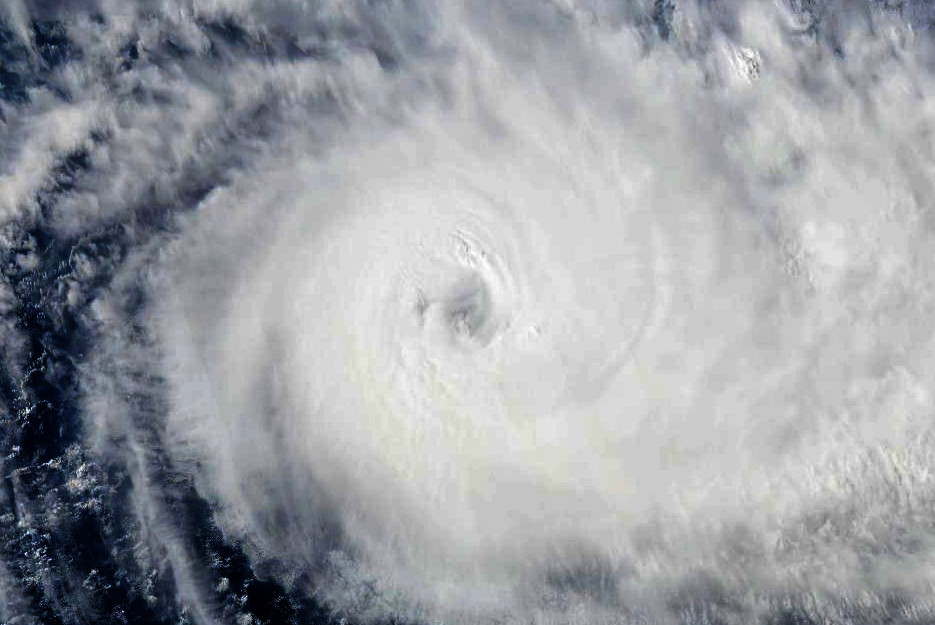One of the precursor projects for Tropical Weather Analytics’ Hurricane Hunter Satellites was the CyMISS (Tropical Cyclone intensity Measurements from the ISS) project which ran from 2014 to 2019. Funded by a series of grants from CASIS (Center for the Advancement of Science in Space) which manages the ISS US National Laboratory for NASA, CyMISS was performed by the science team at Visidyne (the corporate antecedent of Tropical Weather Analytics) for NASA’s Tropical Cyclone Experiment as part of NASA’s CEO (Crew Earth Observations) activities on the International Space Station. The goal of CyMISS was to acquire image sequences of intense tropical cyclones (TCs), such as hurricanes and typhoons, from the ISS using a specially designed photography protocol (see “The Cyclone Intensity Measurements from the ISS (CyMISS)”) to support the development of stereographic imaging techniques of these destructive storms. These techniques will allow the altitudes of the cloud tops near the eye of TCs to be precisely determined so that these TCs can be more accurately characterized compared to existing remote sensing methods (see “Using the Carnot Engine Model to Characterize Hurricanes from Orbit”). Because of how these stereo images are acquired, processed, and analyzed, the motion of cloud features can also be tracked to derive the winds in three dimensions including unique measurements of vertical winds – a vital input for accurately modelling the future track and intensity of TCs (see “The Impact of New Satellite Wind Measurements on Hurricane & Tropical Cyclone Forecasting”)
During the course of this five-year project, the CyMISS project science team (which is now the core of the TWA science team) amassed a large collection of storm images that we wish to share. One of the TCs observed in support of CyMISS by the crew of ISS Expedition 51 was Tropical Cyclone Donna in the South Pacific during a pair of overpasses about 25 hours apart on May 7 and 8, 2017. Tropical Cyclone Donna would prove to be the strongest off-season tropical cyclone ever recorded in the Southern Hemisphere during the month of May.
May 7, 2017
For our first observation opportunity of Tropical Cyclone Donna, the crew of the ISS secured a sequence of 300 images during a five-minute observation session which started at 02:28:00 GMT on May 7, 2017 when the storm was generating sustained winds of about 145 kph (about 90 mph) making this a Category 3 storm on Australian tropical cyclone intensity scale (a strong Category 1 storm on the Saffir-Simpson scale used in North America). A sample image from this sequence is shown below. At this time, Tropical Cyclone Donna was in the South Pacific with the eye located at about 14.2° S, 164.4° W.
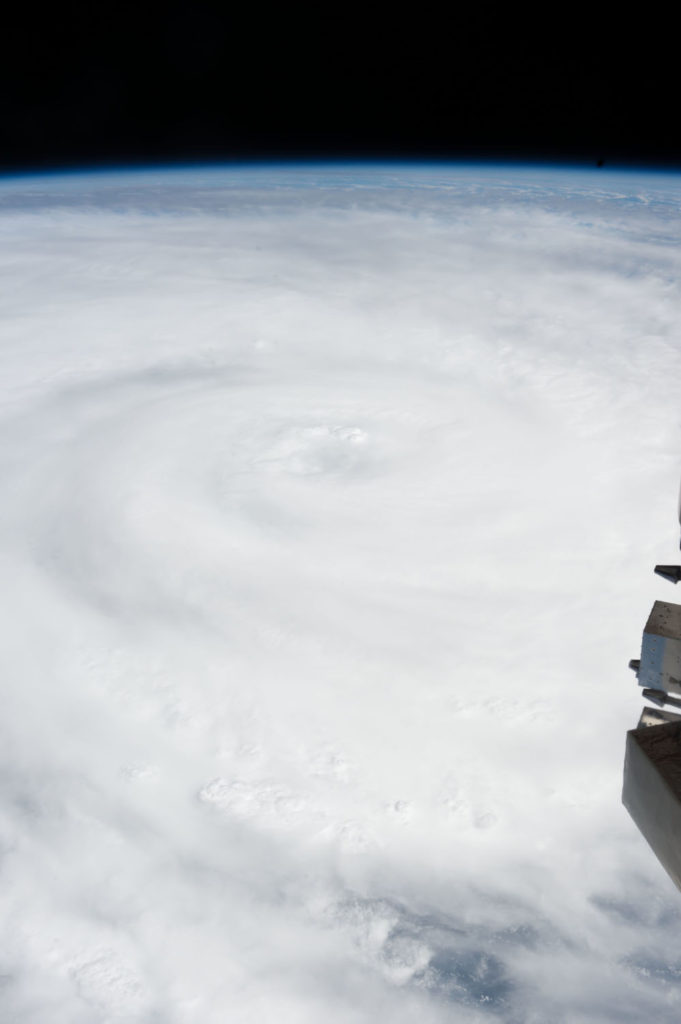
A synoptic 2D color view created from a subset of the ISS photographs taken that day is shown below. In order to create this mosaic, the individual photographs from the original image sequence were remapped to approximate an overhead view before the frames were stitched together into a synoptic view covering an area of approximately 1,200 by 1,000 kilometers. A high-resolution version of this 2D mosaic with an image scale of ~1,000 meters/pixel can be viewed by clicking on the image below.
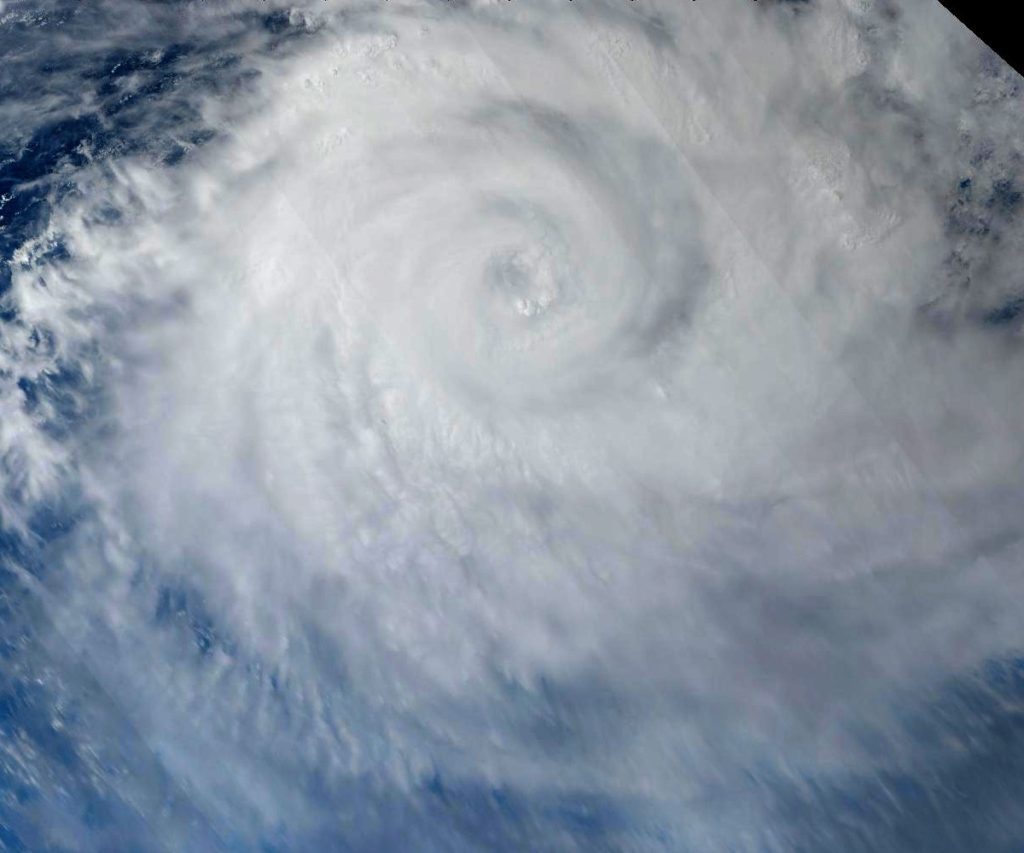
The close-up 3D image shown below was created using a pair of photographs of the 70-kilometer eye of Tropical Cyclone Donna taken a few seconds apart around 02:31:43 GMT. Only the red channel of the original color images was used in order to cut through any atmospheric haze and maximize the visibility of the cloud features. These images were remapped to approximate an overhead view before being combined to create an anaglyphic 3D image. The resulting stereo view, which can be seen at full size with a scale of about 200 meters/pixel by clicking on the image below, covers an area of 225 by 150 kilometers. At this point in the storm’s development, convection within the eyewall began to increase (evidenced by the towering cumulus clouds visible in the lower right corner of the eye) as the storm began to intensify again.
![]()
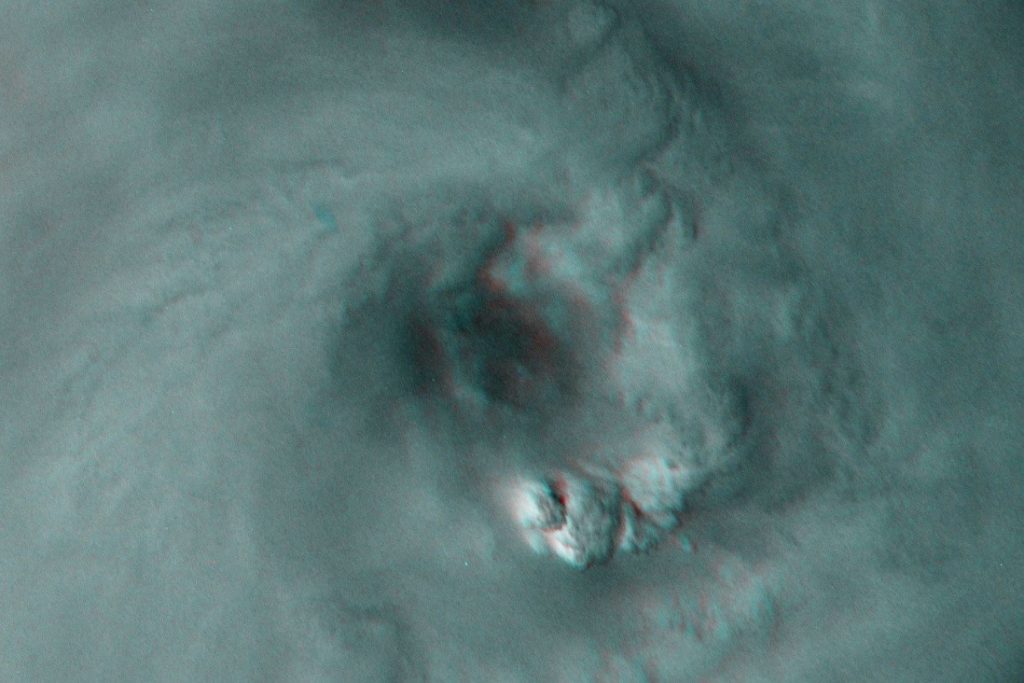
May 8, 2017
Because of the phasing of the ISS orbit and the motion of Tropical Cyclone Donna, the crew of the ISS was able to secure a second sequence of 300 images during a five-minute observation session which started at 03:15:00 GMT on May 8, 2017 – almost 25 hours after the previous day’s observations (see “ISS Daily Summary Report – 5/8/2017”). At this time, Donna was located at about 17.2° S, 165.0° W in the South Pacific about 340 kilometers south of its location when it had been observed the previous day. The storm had just past its peak intensity with winds of 185 kph (115 mph) and was rated as a strong Category 4 storm on the Australian tropical cyclone intensity scale (a Category 3 storm on the Saffir-Simpson scale). A sample image from this sequence is shown below.
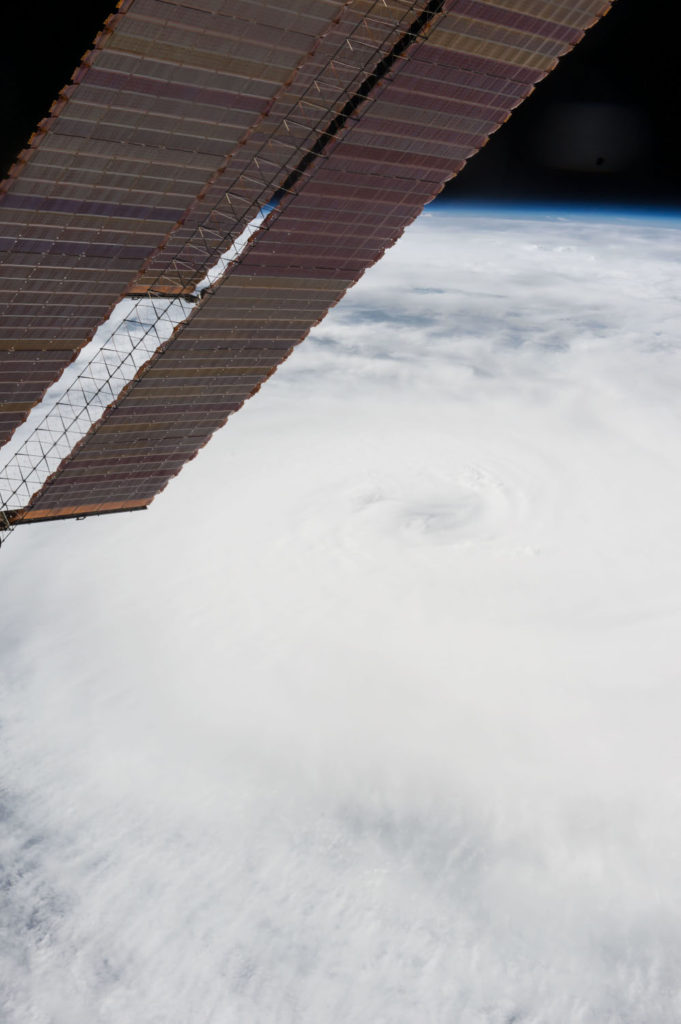
A synoptic 2D color view created from a subset of the ISS photographs taken that day is shown below. In order to create this mosaic, the individual photographs from the original image sequence were remapped to approximate an overhead view before the frames were stitched together into a synoptic view covering an area of approximately 1,200 by 1,000 kilometers. A high-resolution version of this 2D mosaic with an image scale of ~1,000 meters/pixel can be viewed by clicking on the image below.
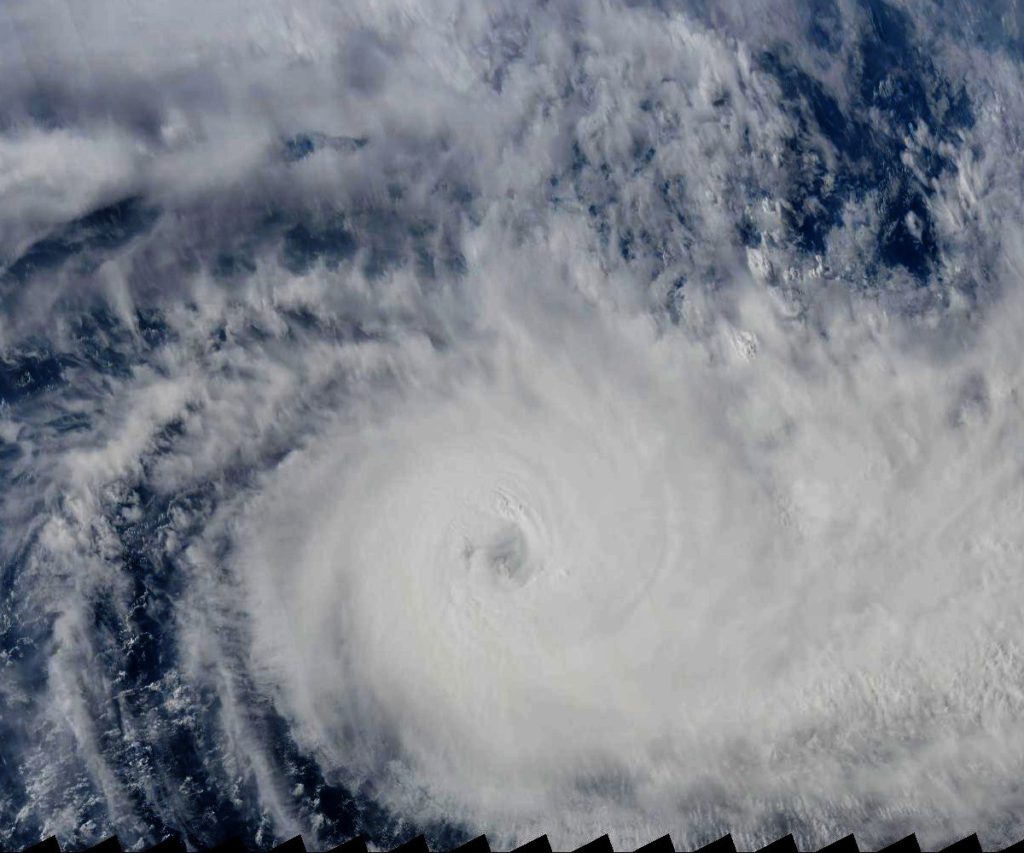
The close-up 3D image shown below was created using a pair of photographs of the 70-kilometer eye of Tropical Cyclone Donna taken a few seconds apart around 03:18:11 GMT. Once again, only the red channel of the original color images was used in order to cut through any atmospheric haze and maximize the visibility of the cloud features. These images were remapped to approximate an overhead view before being combined to create an anaglyphic 3D image. The resulting stereo view, which can be seen at full size with a scale of about 200 meters/pixel by clicking on the image below, covers an area of 225 by 150 kilometers.
![]()
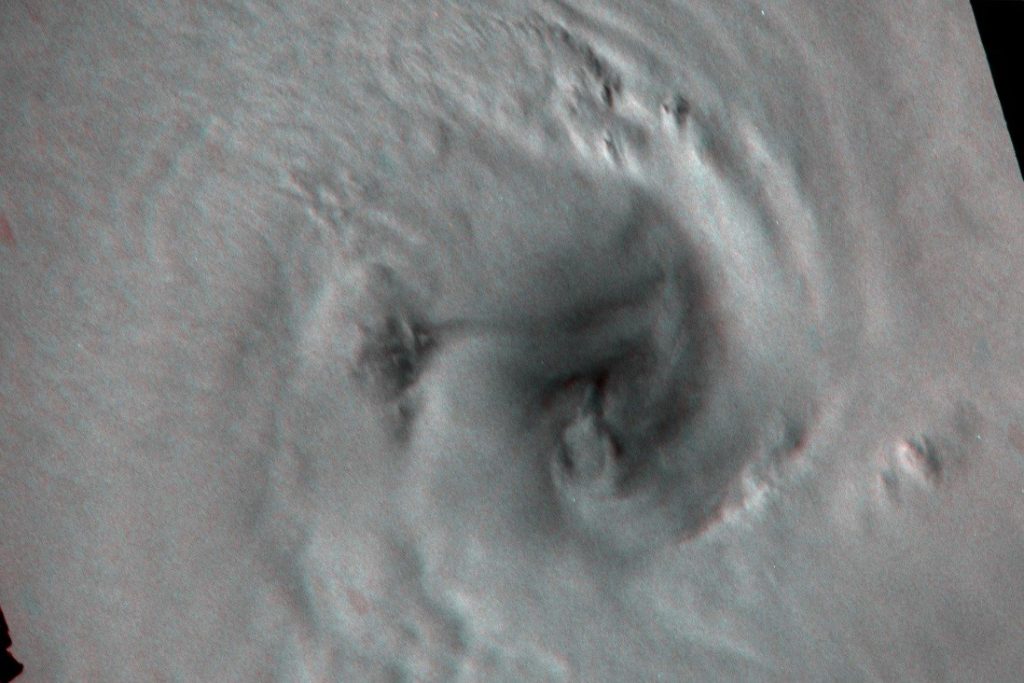
Related Reading
Drew LePage, “The Hurricane Hunter Satellites”, Drew Ex Machina, May 15, 2022 [Post]
Drew LePage, “Using the Carnot Engine Model to Characterize Hurricanes from Orbit”, TWA Blog, July 23, 2022 [Post]
Drew LePage, “The Impact of New Satellite Wind Measurements on Hurricane & Tropical Cyclone Forecasting”, TWA Blog, January 15, 2023 [Post]
Paul Joss, “The Cyclone Intensity Measurements from the ISS (CyMISS)”, Space Station Research Explorer [Page]

